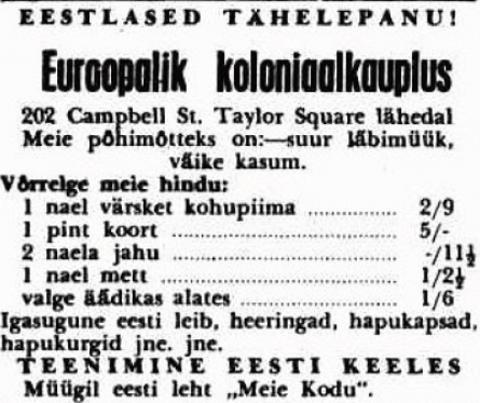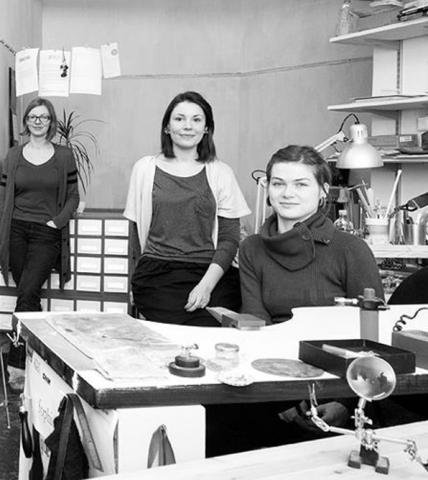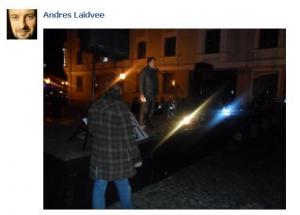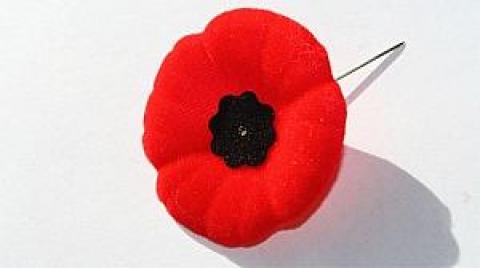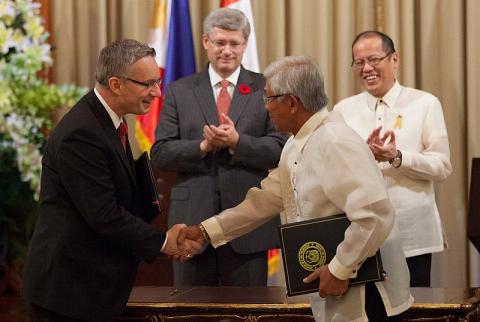By JOHN WEICH
Globe and Mail, Saturday, May 8, 2004 - Page T1
TALLINN, ESTONIA -- Café Narva attracts a strange crowd, an admixture of aging Russians and tragically hip Estonians who have turned this place into an institution more or less against its want or will. Café Narva, with its overriding shades of brown, wood-panelled walls, its surly service and retro uniformed waitresses who shoot you angry looks when you order a cappuccino because everyone asks for them but they are decisively not on the menu. Café Narva, situated in the centre of the Estonian capital of Tallinn, is every bit as charming as retro Soviet cafés in Helsinki, Prague and Berlin -- polished surfaces, dodgy cuisine, but ultimately satisfying because you know deep down that one day these places will disappear forever.
Tallinn is a city most Westerners haven't heard of but which for years has been on the travel agenda of connoisseurs of the former Eastern Bloc. It is infinitely edgier than Prague, which for most of the 1990s enjoyed global recognition as Europe's most well-preserved urban museum and as such attracted a heady stream of European and North American expatriates. But the Prague they sought out in the early 1990s has since settled into cozy complacency, a city that is reaping the benefits of a mature tourist industry, the second city in Central Europe's extraordinarily popular urban troika -- Vienna, Prague and Budapest. On a trip to Prague in the mid-1990s, I nestled up to a horde of Italian and German tourists and stared up at the hourly Apostle procession of the Town Hall Clock. In the chilly spring air and amid the seemingly endless tour buses that even then parked on both sides of the Charles Bridge, I concluded what I had known for years: for trailblazing travellers Prague was a no-go. What I needed was a new Prague -- and that new Prague was Tallinn.
Situated just 80 kilometres south of the Finnish capital of Helsinki, Tallinn can stake claim to being capital of the most forward-thinking Baltic republic. It is an exquisitely sculpted city, its old centre every bit as medieval as Prague's; like the latter, it is a UNESCO World Heritage Site. Like Prague, Tallinn remains remarkably intact after centuries of on-again-off-again occupations by foreign armies, with arching gateways, grey towers topped with red tiles and narrow, cobblestone streets spreading out fanlike from Raekoja Plats (Town Hall Square). Originally one of Northern Europe's most fortified cities, Tallinn's ramparts are clearly visible, and 19 of the original 66 towers are still standing.
Yet while beauty entices you to Tallinn's city gates, the reason most go there is that it is still a relatively uncharted region for the majority of the world's travelling citizens. When I first visited the Baltic States -- Latvia, Lithuania and Estonia -- in 1991, they were still isolated from Western influence and virtually anonymous, albeit shell-shocked by the sudden fall of the Soviet Union. In the mid-1990s, the three countries enjoyed slight celebrity as difficult questions on game shows like Jeopardy or as tongue twisters in novels by Don DeLillo. But the Baltic republics have grown since then. They quickly asserted their independence and have evolved so greatly that they have convinced Brussels that they can function as any other European nation.
Circa 2004, Tallinn is a magnet for discerning 20- and 30-something Europeans enticed to this Baltic boomtown for all the right reasons. Estonians, for a start, are infinitely more Scandi than Slavic, and they look, dress and act like their Swedish neighbours across the Baltic Sea. Even the architecture and design, with its sleek lines and stark interiors, are categorically Swedish. It was only a matter of time before Northern European creative types found their way to Tallinn. Some of the new arrivals were even inspired to create guides to the city, whose beauty and intimacy had a much more immediate impact on European shakers and movers than the likes of Lonely Planet and Rough Guide.
One such "memoir" was the 24 Hours guide, launched in 2002, which reinforced the city's reputation as a hip respite by celebrating on large-format paper Tallinn's coolest bars, its most profound tourist sites and its most interesting citizens.
The Estonia government, however, was hardly a passive bystander. A few years ago it commissioned London branding agency Identica to revamp its image in an effort to increase tourism and attract foreign investment. Identica created a new slogan ("Welcome to Estonia"), designed a funky new passport stamp and produced a series of brochures whose quality and professionalism underscored the country's forward-thinking mindset. Indeed, the Identica rebranding makes Tallinn look more like a monthly lifestyle magazine destination than it did a tourism brochure, which was exactly the point. It left no doubt as to what type of tourist it was interesting in attracting: the jet set.
24 Hours and the Identica rebranding reinforced what most people familiar with Estonia knew already: It is a hard place not to like. It is as small as the Netherlands with only a tenth of its population. This is also a country that in 1988 embraced its national identity -- and peacefully escorted Soviet rule out of town -- by singing traditional songs in what has since become known as the Singing Revolution. A year later, in 1989, Estonians joined hands with Latvians and Lithuanians -- again, in protest of Soviet rule -- to form a massive human chain two million people strong stretching across three countries. It was a non-violent approach to survival for a country that has learned to live with an enormous and historically aggressive neighbour, Russia. You can't help but like Estonia; or rather, if you don't like Estonia, who do you like?
This is the attitude adopted by Tallinn's latest clutch of pioneers and it is still heavily pervasive in the city today. But beyond the chic bars, the beautiful people and well-lit clubs, Tallinn also has a heavy trade in retro Soviet chic, which gives it a distinct edge over its Western European counterparts and even Moscow, which is doing its best to erase its Soviet past as quickly as possible. Café Narva is just one example of this. While Raekoja Plats and the compact centre have remained sheltered from the wear and tear of the Soviet period's worst planning atrocities, some of the city's most interesting monuments are Soviet-era throwbacks. Soviet urban-planning buffs are advised to make the journey to the large-scale mass housing developments like Lasnamae and Vaike-Oismae.
Closer to town, however, are two Soviet-era seaside monuments. The Maarjamae Memorial Complex, which commemorates Soviet power during the Second World War, attracts locals less for its revisionist ideology than for its poetic aura, and the open-air theatre Lauluvaljak is the birthplace of the Singing Revolution. Towering above the city is the 324-meter TV Tower, erected for the 1980 Olympics, with its impressive array of curved stained glass by Estonian artist Dolores Hofmann depicting the technology of TV through stoic proletarian images.
In the last decade, many former East Bloc countries have steadily cultivated an infrastructure that suits their increasingly Western populations. Tallinn has followed suit, and with the help of Scandinavian investors, the city has a sophisticated bar and club scene that rages well into the night. Tallinn has integrated itself into the DJ circuit and attracts some of Europe's best spinners, who perform in enormous clubs where the women outnumber the men plentyfold. This all says that Tallinn is every bit as interesting as Prague, but without the extra weight of low-budget travellers and, worse, bachelor parties flown in from London and Liverpool.
It's hard to say how long Tallinn will be able to hold the masses at bay. Geography, weather and size ensure that the Estonian capital will never become the expatriate centre of the Central European staples, but that doesn't mean the city will go without a good PR fight. Estonia already boasts one of EU's highest Internet connections per capita, ranking ahead of the UK, Germany, Belgium and France, and back in 2000 it was one of the first governments to change its cabinet meetings to paperless sessions. All these efforts have helped raise Estonia's profile to the point that it can no longer be referred to as a European outback. It is a country on the move, one of the most interesting and idyllic in Europe's north. And Tallinn is as beautiful a capital as a country could ever want.
John Weich currently splits his time between Amsterdam and Istanbul as editorial director of 34 Magazine, the recently launched global lifestyle magazine.
THE NEW EUROPE NEXT SATURDAY: A LITHUANIAN ROAD TRIP
Essential Estonia
Capital: Tallinn
Population: 1,415,681
Currency: Kroon (1$C = approximately 10 kroons).
Language: Estonian, an increasing amount of English and a rapidly decreasing amount of Russian.
Highlight: Estonia allows you to experience northern Europe for about half the price it would cost you on the other side of the Baltic. Maybe not as cheap as you'd like, but it's hard to argue with $.50 coffee or a full meal for $10 in a prime Old Town café (especially if you've just come from Scandinavia). As great as Tallinn is, get out of the city and into the countryside to enjoy true serenity.
Headaches: Like almost all urban centres in Europe, Tallinn is prone to pickpocketing and purse-snatching, an experience exacerbated by the fact that local police have a limited command of English. Beware of large groups of Finns, over a million of whom visit Estonia each year. You can thank them, at least partly, for driving up the prices.
More details: The Estonian Tourist Office in Toronto is represented by Baltic Design Tours, phone (416) 221-4164 or 1-800-361-9487. Useful websites include: http://www.restoranpegasus.ee.
Café Narva: Narvan mnt. 10; (372) 660 1786.
Café Bonaparte: Pikk 45; (372) 646 4444.
CORRECTION: EU visas
Travellers no longer need tourist visas to travel to any country in the expanded European Union. As of May 1, the Czech Republic and Poland dropped visa requirements for Canadian travellers visiting the countries for up to three months. Incorrect information, based on the position of both countries at our deadline, was published in the Travel section on May 1.
Tallinn's inner beauty (4)
Kuumad uudised | 08 May 2004 | EWR
Viimased kommentaarid
Kommentaarid on kirjutatud EWR lugejate poolt. Nende sisu ei pruugi ühtida EWR toimetuse seisukohtadega.
on vist poliitilist korrektsust silmas pidades lisanud huvitava valiku lõbustus- elik söögikohtadest - alates homoklubist ja lõpetades trendiinimeste eneseimetlemise kohaga.
Kindlasti neid kohti külastades saab suurepärase ülevaate nii esimesest kui viimasest;) Eestist.
Kindlasti neid kohti külastades saab suurepärase ülevaate nii esimesest kui viimasest;) Eestist.
Minu viga vist... Ma ei joudnud paris lopuni veel artiklit lehest lugeda. Vaatasin "More Details" alt milleni artikkel oli paris sarnane. "More Details" i all aga oli tallinn.ee,tourism.ee ja inyourpocket.com.
Vaata www.globeandmail.com ja otsi "Estonia"
Artikli lõpus on:
NIGHTLIFE/RESTAURANTS
Nightman : Vineeri 4;
http://www.nightman.ee
Hiireloks: Sakala 14, Tallinn; (372) 660 4541.
Pegasus: Harju 1; (372) 631 4040; http://www.restoranpegasus.ee.
Café Narva: Narvan mnt. 10; (372) 660 1786.
Café Bonaparte: Pikk 45; (372) 646 4444.
Artikli lõpus on:
NIGHTLIFE/RESTAURANTS
Nightman : Vineeri 4;
http://www.nightman.ee
Hiireloks: Sakala 14, Tallinn; (372) 660 4541.
Pegasus: Harju 1; (372) 631 4040; http://www.restoranpegasus.ee.
Café Narva: Narvan mnt. 10; (372) 660 1786.
Café Bonaparte: Pikk 45; (372) 646 4444.
Kuumad uudised
TRENDING






